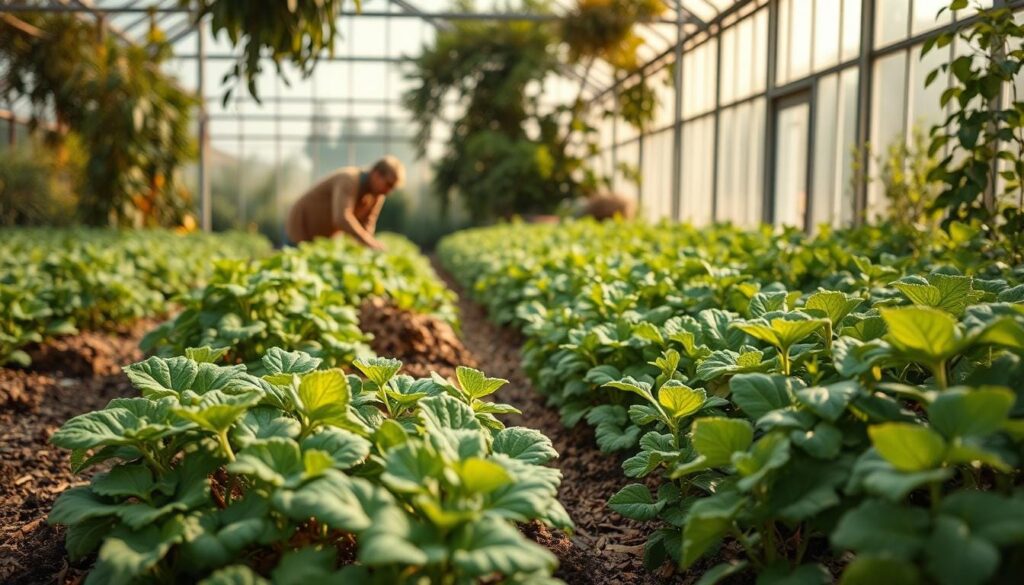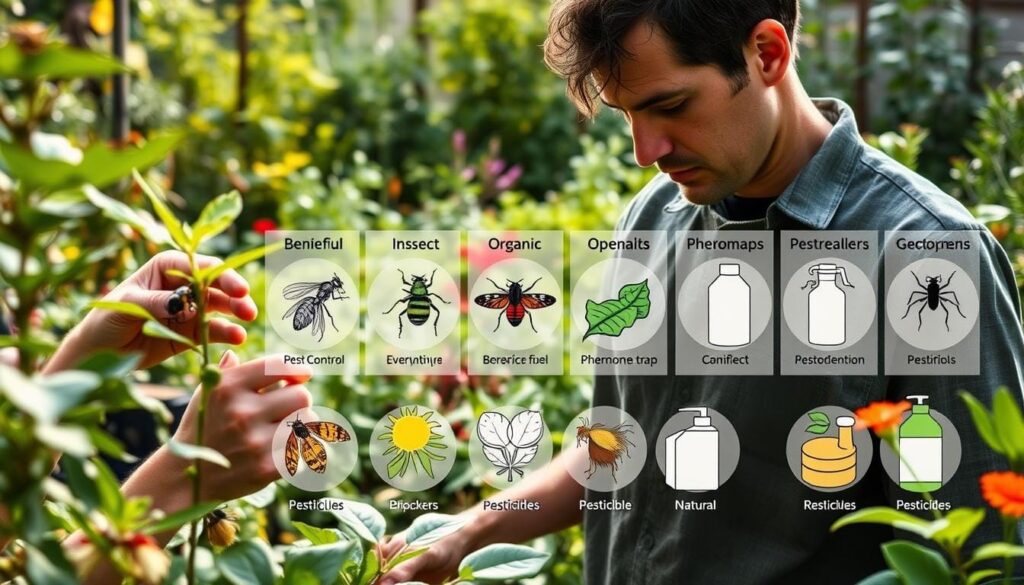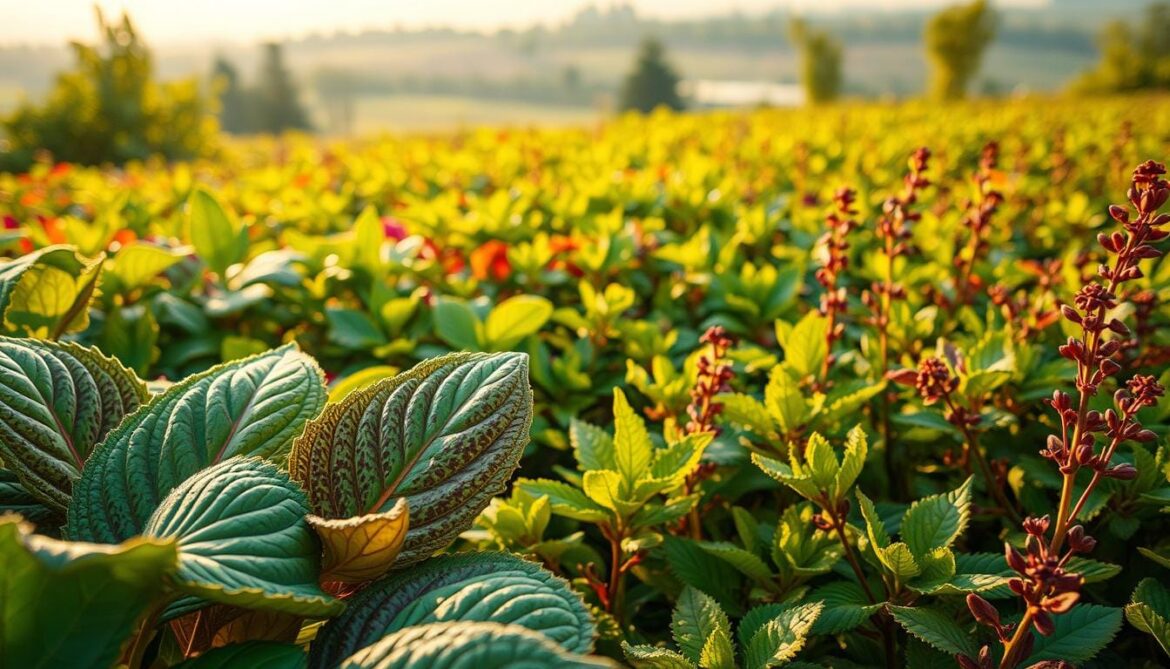Every gardener and farmer knows the pain of losing a thriving crop to disease. Anthracnose can turn a promising harvest into a disaster. It’s a big worry for those who rely on healthy plants.
The fight against anthracnose starts with knowing the enemy. This fungal disease can destroy crops, leading to big economic losses. Fungicides are key in fighting this plant threat, protecting against severe outbreaks.
Colletotrichum species, the main cause of anthracnose, include over 200 fungal types. They can harm crops badly, causing up to 80% loss in some cases. So, finding good ways to treat anthracnose is vital for growers.
Key Takeaways
- Anthracnose is a widespread fungal disease affecting multiple plant types
- Early detection is key for managing the disease
- Fungicides are a main defense against anthracnose spread
- Different plants need different treatments
- Using a mix of pest management methods can lessen disease impact
Understanding Anthracnose Disease in Plants
Anthracnose is a complex fungal disease that affects plant health in many places. It’s important to understand it well to manage and protect plants effectively.
What Causes Anthracnose Disease?
Anthracnose comes from Colletotrichum fungal species. These tiny pathogens attack specific plants. They grow best in cool, moist places and can harm crops a lot.
- Caused by specialized fungal spores
- Targets specific plant species
- Spreads through environmental conditions
Symptoms of Anthracnose in Different Plants
Plant symptoms can vary but often show clear signs of fungal attack. Knowing these signs is key to early detection and management.
- Dark, sunken lesions on leaves
- Irregular leaf spots
- Premature leaf drop
- Twig and branch dieback
How Anthracnose Spreads
Anthracnose spreads in many ways, with the environment playing a big role. Choosing resistant plants is a smart way to fight off the disease.
*Environmental conditions like high humidity and moderate temperatures create ideal conditions for anthracnose spore germination*
Spores can spread through:
- Wind transportation
- Rain splash
- Irrigation systems
- Direct plant contact
By monitoring closely and using a mix of management strategies, we can lessen the disease’s effects.
Types of Plants Affected by Anthracnose
Anthracnose is a harmful fungal disease that harms many plants in various places. Knowing which plants are most at risk helps gardeners and farmers fight it better.
Commonly Affected Vegetables
Many vegetable crops are hit hard by anthracnose. The most affected veggies are:
- Tomatoes
- Beans
- Cucumbers
- Peppers
These veggies often get wet-looking spots on their leaves and fruits. Tomatoes, for example, can get water-soaked spots that grow and ruin the fruit.
Impact on Ornamental Plants
Ornamental plants also suffer from anthracnose. Roses and dogwoods are very prone to it. Cutting off infected parts regularly can help stop the disease from spreading.
Anthracnose in Trees and Shrubs
Many trees and shrubs face big problems with anthracnose. Some examples are:
- Sycamores (American and California species)
- Chinese elm trees
- Black oak and coast live oak
Rotating crops and managing landscapes well can lower anthracnose risks in these plants. If not treated, the disease can cause plants to lose all their leaves, which is bad in humid areas.
Start preventive treatments early in the growing season to protect plants from anthracnose.
Prevention Strategies for Anthracnose
To stop anthracnose, we need a plan that uses many methods. It’s about making a space where fungi can’t grow and keeping plants healthy.
Crop Rotation: Breaking the Disease Cycle
Crop rotation is key to fight anthracnose. Farmers and gardeners should:
- Wait 3-4 years before replanting the same crop in the same spot
- Remove infected plant parts in fall to cut down spore buildup
- Switch to different plant families to stop disease spread
Optimal Watering Practices
Managing water is vital to stop anthracnose. Keeping moisture in check helps avoid fungal infections. Here’s how to do it:
- Choose drip irrigation over overhead sprinklers
- Water plants in the morning so they dry fast
- Don’t spray water on leaves when watering
Selecting Resistant Plant Varieties
Picking the right plants can lower anthracnose risk. Look for ones made to fight off fungi. Local offices can suggest the best varieties for your area.
Prevention is always better than treatment for plant diseases.
Using these strategies, gardeners and farmers can lower anthracnose risk. This keeps plants healthy and productive.
Chemical Treatments for Anthracnose
Managing anthracnose disease needs a smart plan for fungicide use. Effective anthracnose disease treatment means picking the best fungicides and using them at key times.
Overview of Common Fungicides
Experts suggest several strong fungicides for fighting anthracnose. The top choices are:
- Chlorothalonil: A protective fungicide that stops fungal spread
- Copper sprays: Made with copper diammonia diacetate
- Propiconazole: A systemic fungicide for full protection
- Thiophanate-methyl: A professional-grade treatment
Optimal Timing for Chemical Treatments
Timing is everything when using fungicides. Preventative treatments work best before symptoms show. Studies show fungicide programs should start 2-4 weeks before disease hits.
Safety Measures for Fungicide Use
Using chemicals for treatment needs careful steps. Here are key safety tips:
- Wear protective gear
- Read labels carefully
- Measure doses accurately
- Avoid spraying in windy weather
- Keep chemicals in safe places
Knowing about restricted entry intervals (REI) and preharvest intervals (PHI) is key. Always switch fungicides to avoid resistance and protect the environment.
Organic Solutions for Anthracnose
Gardeners and farmers looking for green ways to fight plant diseases have many options. They can use natural methods that work well with plants and the environment. This approach is part of integrated pest management.
Instead of using harsh chemicals, natural treatments are a better choice. They keep plants healthy and don’t harm the environment. Biological control agents are a key part of this approach, fighting anthracnose without harming plants.
Neem Oil: A Powerful Natural Fungicide
Neem oil is a top pick for fighting anthracnose. Mix 1 tablespoon of neem oil per quart of water and apply it weekly. This natural fungicide can really slow down the disease.
- Disrupts fungal growth mechanisms
- Safe for most plant varieties
- Environmentally friendly application
Beneficial Microorganisms in Disease Prevention
Adding beneficial microorganisms like Bacillus subtilis can help fight anthracnose. These tiny helpers compete with harmful fungi. They help keep plants healthy.
Healthy soil ecosystems are the first line of defense against plant diseases.
Sulfur: A Traditional Organic Prevention Method
Sulfur-based treatments are a tried-and-true method for fighting disease. When used right, sulfur makes it hard for fungi to grow. This supports the idea of integrated pest management.
By mixing different organic methods, gardeners can create strong plans to prevent anthracnose. These plans keep plants healthy without harming the environment.
Cultural Control Techniques
Managing anthracnose needs a full plan to stop disease spread and keep plants healthy. Good control methods focus on stopping the disease before it starts. They also aim to make the environment less friendly to the disease.

Proper Sanitization Practices
Keeping your garden clean is key to stop disease spread. Important cleaning steps include:
- Removing and destroying infected plant material right away
- Disinfecting gardening tools after each use
- Cleaning greenhouse and garden surfaces often
- Throwing away infected debris far from where plants grow
Optimal Pruning Techniques
Pruning wisely can really help stop anthracnose. Pruning infected plants needs careful steps:
- Use sterilized pruning tools
- Cut at least 6 inches below where you see infection
- Prune when it’s dry to avoid spreading spores
- Make sure plants have good air flow
Soil Health and Its Impact
Healthy soil fights off anthracnose well. Good gardening practices boost plant strength:
- Keep soil pH right
- Add organic stuff to improve soil
- Rotate crops to stop disease from coming back
- Make sure soil drains well to avoid too much moisture
Remember: Prevention is always more effective than treatment when managing plant diseases.
Environmental Factors Influencing Anthracnose
It’s important to know what environmental factors help anthracnose grow. Climate conditions play a big role in how fast and far this plant disease spreads.
Experts have found several key environmental factors that help anthracnose grow well. These factors make it easier for the disease to infect plants and spread.
Humidity’s Critical Role
Humidity is very important for anthracnose to spread. The disease does best in:
- High moisture levels
- Extended periods of leaf wetness
- Poor air circulation
Temperature’s Impact on Disease Progression
Temperature greatly affects how anthracnose grows. Moderate temperatures between 60-80°F are perfect for fungal spores to grow and infect plants. Warmer, wet springs make the disease spread faster in many plants.
Sunlight and Disease Pressure
Sunlight affects how common anthracnose is. Dark, damp places are great for fungi to grow. More sunlight and better air flow can help plants fight off the disease.
Gardeners and farmers can use this knowledge to stop anthracnose early. This helps protect their crops from damage.
Monitoring and Early Detection
Early detection is key to managing anthracnose disease well. Growers need to watch their crops closely. This helps prevent big losses in yield.
Starting with the early signs of anthracnose is important. New tech like remote sensing helps a lot. It makes spotting plant health problems more accurate than ever.
Critical Signs to Identify in Plants
Spotting anthracnose symptoms takes a close look at plants. Look for:
- Dark, sunken spots on leaves and fruits
- Leaves falling off too early
- Stalk rot and growth problems
- Unusual color changes and spots
Advanced Monitoring Techniques
Today’s tech offers advanced ways to check plant health. For example, multispectral imaging is very good at finding problems:
| Technology | Detection Accuracy | Spectrum Range |
|---|---|---|
| Multispectral Imaging (MSI) | 98% at leaf level | 350-1000 nm |
| Hyperspectral Imaging (HSI) | 94% at pixel level | Broad spectral range |
Regular Plant Inspection Best Practices
Regular checks are vital for catching problems early. Here’s what experts suggest:
- Do a full plant check every week
- Keep a record of any changes
- Watch the weather and soil
- Use digital tools to track
By mixing new tech with old ways, farmers can fight anthracnose. They do this by catching problems early and using a smart pest management plan.
Integrated Pest Management (IPM)
Integrated Pest Management is a detailed way to fight plant diseases like anthracnose. It uses many methods to stop and manage pests. The aim is to find a lasting, green solution for plants.

Understanding IPM Fundamentals
IPM is about stopping pests for good with a big-picture plan. It uses natural helpers instead of chemicals. Good plant disease control means looking at the whole ecosystem.
- Identifies pest problems early
- Combines multiple control methods
- Minimizes environmental impact
- Reduces reliance on chemical treatments
Combining Methods for Optimal Results
Good IPM mixes different ways to fight pests. Gardeners and farmers can fight anthracnose well by using these methods:
| Control Method | Key Benefits |
|---|---|
| Cultural Control | Crop rotation, proper sanitation |
| Biological Control | Use of beneficial microorganisms |
| Chemical Control | Targeted fungicide applications |
Case Studies of Effective Implementation
Real-world examples show the strength of integrated pest management. Farmers who use full IPM plans often see less disease and healthier crops. By watching the environment and acting early, growers can beat anthracnose and other diseases.
IPM is not just a method, but a holistic approach to plant health management.
Impact of Anthracnose on Crop Yield
Anthracnose is a big problem for farmers, causing a lot of damage to crops. It can lead to huge financial losses for those who grow crops.
The effects of anthracnose on crops are very serious. Here are some numbers that show how much crops can lose:
- Soybean yields can drop 16% to 26% in the United States
- Tropical regions like Thailand experience yield losses between 30% to 50%
- In Brazil and India, crop losses can reach a staggering 100%
Economic Implications for Farmers
For farmers who rotate their crops, knowing about anthracnose is key. A small amount of disease can mean big losses. For example, a 1% increase in disease can lead to losing about 90 kg/ha of grain.
Long-term Effects on Plant Health
When anthracnose keeps coming back, it can really hurt plants. Using resistant plants is important to keep plants healthy. Plants that keep getting sick become weaker and less productive over time.
Mitigating Yield Loss
| Mitigation Strategy | Potential Yield Protection |
|---|---|
| Crop Rotation | Up to 40% reduction in disease spread |
| Resistant Varieties | 25-50% decreased infection risk |
| Timely Fungicide Application | 30-45% yield preservation |
By planning ahead, farmers can fight anthracnose. This includes rotating crops, choosing strong plants, and using the right treatments. These steps can help a lot in reducing the damage caused by anthracnose.
Seasonal Considerations for Treatment
Managing anthracnose needs a flexible plan that changes with the seasons. It’s important to know how the weather affects the disease. This knowledge helps protect plants better.
Treatment Strategies for Different Seasons
The weather greatly influences anthracnose growth. The disease grows best in warm, humid weather.
- Spring: Watch for early signs of infection
- Summer: This is when the disease spreads the most
- Fall: Clean up and prevent the disease
- Winter: Focus on soil care and cultural practices
Seasonal Monitoring Techniques
Good cultural practices are key for tracking anthracnose. Farmers and gardeners should watch temperature, humidity, and plant growth closely.
- Keep an eye on local weather
- Regularly check your plants
- Use digital tools for monitoring
- Keep a record of disease progress
Adjusting Care Based on Weather
Different weather calls for different treatments. Anthracnose grows fastest in temperatures between 75 to 82°F with lots of moisture. Adjust your care plans:
- Water less when it’s wet
- Improve air flow
- Remove sick plants
- Choose plants that are resistant
Understanding seasonal changes and using the right strategies can help gardeners fight anthracnose. This way, they can keep their plants safe all year.
Research and Innovations in Treatment
Agricultural technology is changing how we fight plant diseases. New research is giving us better ways to handle anthracnose. This is good news for farmers and gardeners.
Recent Studies on Anthracnose Solutions
New studies have brought us closer to controlling anthracnose. Scientists have found new ways to fight this tough disease. Some big discoveries include:
- Advanced remote sensing with hyperspectral imaging
- Machine learning to detect diseases
- Technologies for precision farming
Innovations in Disease Resistance
Researchers are working hard to make plants resistant to anthracnose. They’re using genetic engineering and old-school breeding to do this. This is creating plants that can fight off the disease better.
Biological control agents are also being explored. These use natural microorganisms to fight plant diseases. It’s a greener way to manage diseases.
Future Directions for Treatment Development
The future for fighting anthracnose looks bright. New tech is making it easier to find and stop diseases. For example, machine learning is getting really good at spotting diseases:
- 100% accurate in finding hidden fungal infections
- 99.1% accurate for healthy plants
- 94.5% accurate for plants showing symptoms
Digital tools for precision farming are getting better too. They help growers track diseases and treat them more effectively.
Conclusion: Effective Anthracnose Disease Management
Managing anthracnose disease needs a full plan that uses many methods. Farmers and experts must see how big of a problem it is. It can cause losses of 25% to 40% in crops like papaya and mango.
Integrated pest management (IPM) is key to fighting anthracnose. It mixes cultural practices, resistant plants, and specific actions. This way, growers can cut down on losses and keep their farms safe.
Long-term prevention of anthracnose is important. Crop rotation, choosing the right seeds, and watching the weather can help a lot. Scientists are also looking into new ways, like essential oils and better CO2 control, to fight the disease.
For anthracnose management to work, education, research, and teamwork are essential. Farmers need to stay open to new ideas and technology. This helps protect their crops and ensures we have enough food in a tough farming world.

